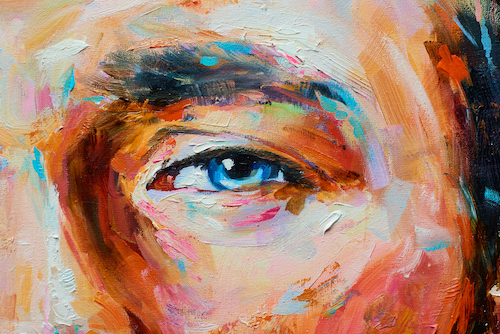Original Still Life and Floral Oil Paintings for Sale
Original Still Life and Floral Oil Paintings for Sale
Blog Article
Discovering Everything About Oil Paintings: A Guide to Understanding Their Elegance and Value
Oil paintings have captivated audiences for centuries, supplying a glimpse into the creative mastery of various eras. Their rich history is linked with cutting-edge strategies and profound emotional expression. Recognizing the products and methods behind these artworks can boost gratitude. Furthermore, the marketplace for oil paintings presents possibilities for investors and collection agencies alike. As one explores this interesting globe, the question arises: what makes an oil painting genuinely useful?
The Background of Oil Painting: A Journey Via Time
Oil paint has roots that date back to old times, it truly prospered during the Renaissance, when musicians uncovered its adaptability and rich shade possibility. Early instances can be mapped to the 7th century, with methods advancing especially throughout cultures. The tool came to be popular in Northern Europe in the 15th century, especially with the works of artists like Jan van Eyck, that originated its usage for thorough realism and vibrant colors. This period noted a departure from tempera paints, enabling greater depth and texture. As oil painting spread, it affected many musicians, bring about masterpieces by distinguished figures such as Leonardo da Vinci and Rembrandt. The tool's heritage continues, shaping the art globe well into modern times.
Comprehending Oil Repaints: Materials and Techniques
As musicians discover the world of oil paints, they experience a diverse array of materials and methods that define this tool. The key elements of oil paint consist of pigments, which supply color, and drying oils, such as linseed, that bind the pigments and promote application. Different ingredients can modify the paint's appearance and drying time, improving versatility. Techniques like glazing, where clear layers are developed, and impasto, which entails applying thick paint, permit different visual impacts. In addition, using brushes, palette knives, and even fingers can create unique structures and finishes. Comprehending these techniques and products enables musicians to completely share their creativity and achieve the wanted impact in their art work.
The Function of Shade in Oil Paintings
Shade plays a crucial role in oil paints, affecting both visual charm and psychological vibration. Comprehending shade theory essentials, consisting of the relationships between shades, can boost an artist's ability to share state of mind and ambience. In addition, mastering color mixing techniques permits for better depth and splendor in a painting's combination.

Shade Theory Basics
Recognizing color theory is crucial for musicians dealing with oil paints, as it creates the foundation for developing visually engaging and harmonious make-ups. Shade theory encompasses the study of just how colors interact, the color wheel, and the connections in between main, secondary, and tertiary colors. Musicians utilize complementary shades to enhance contrasts and develop centerpieces, while similar colors advertise unity and cohesiveness within an item. Furthermore, the principles of awesome and warm shades influence the assumption of depth and space in a paint. Realizing these concepts enables artists to control color successfully, guiding the viewer's eye and communicating their desired message. Mastery of color concept inevitably enhances a musician's capacity to share emotions and concepts via their work.
Emotional Effect of Color
The psychological influence of color in oil paints plays a crucial function in exactly how visitors view and connect with artwork. Shades evoke details feelings and moods, affecting the visitor's psychological state. For example, cozy tones like reds and oranges can create a sense of heat and power, while awesome tones such as blues and environment-friendlies often stimulate peace or introspection. Artists strategically choose color palettes to boost narrative elements, leading the audience's psychological journey. The saturation and contrast of shades better magnify these results, attracting interest and producing focus. Eventually, the interplay of colors in oil paints not only enhances their visual charm but additionally acts as an effective medium for emotional expression, enhancing the customer's experience and interpretation.
Shade Mixing Techniques
While numerous elements of oil paint add to the overall make-up, understanding color blending strategies is essential for attaining desired effects and deepness. Color blending can be come close to through different methods, including the additive and subtractive processes. Additive mixing includes integrating shades of light, while subtractive blending counts on pigments, where shades blend to create new shades. Artists typically utilize a minimal palette to develop harmonious works, recognizing the relationships between key, additional, and tertiary shades. Techniques such as glazing and scumbling better boost deepness and brightness. By masterfully blending shades, a musician can evoke emotions, develop focal points, and attain a feeling of realistic look, ultimately boosting the painting's emotional and aesthetic effect.
Famous Oil Painters and Their Iconic Functions

Famed for their proficiency of color and method, oil painters have produced a few of one of the most renowned art work in history. Renowned musicians like Vincent van Gogh mesmerized target markets with his stirring brushwork in "Starry Evening," while Claude Monet's "Perception, Dawn" laid the groundwork for Impressionism. Leonardo da Vinci's "Mona Lisa" remains an enduring sign of artistic genius, showcasing his skill in capturing human expression. On the other hand, Rembrandt's "The Evening Watch" shows his ingenious usage of light and darkness. Various other significant numbers consist of Pablo Picasso, that transformed contemporary art with his strong testing in jobs like "Les Demoiselles d'Avignon," and Georgia O'Keeffe, whose vivid representations of landscapes and blossoms helped define American innovation. Each musician's unique style contributed significantly to the oil paint landscape.
Exactly how to Evaluate the High Quality of an Oil Paint
Examining the high quality of an oil painting involves a cautious evaluation of workmanship techniques, in addition to an analysis of shade and composition. Observing brushwork, layering, and the application of paint can reveal the musician's skill level. Furthermore, the interaction of shades and the total arrangement of elements add considerably to the painting's visual value.
Assessing Workmanship Techniques
A careful assessment of workmanship strategies is vital for identifying the high quality of an oil painting. Critics must initially check out the application of paint; thick, textured brushstrokes may suggest a knowledgeable hand, while excessively uniform applications could suggest an absence of depth. oil paintings for sale. The layering technique is also crucial; the presence of glazes and varied thickness can improve luminosity and complexity. Furthermore, the top quality of the products made use of, such as the canvas and pigments, plays a significant function in sturdiness and overall visual. Focus to detail in aspects like sides and shifts in between colors mirrors the musician's dedication to their craft. Eventually, these techniques add to the paint's emotional effect and market price, serving as indications of the musician's ability and intent
Evaluating Shade and Structure
While assessing the top quality of an oil painting, one should focus on the interplay of shade and make-up, as these components are fundamental to the artwork's overall impact. Shade choices can develop and stimulate emotions state of mind; as a result, the artist's combination must be analyzed for consistency and comparison. A healthy composition guides the customer's eye and creates a sense of unity. Artists typically utilize techniques like the guideline of thirds or leading lines to improve visual interest. Additionally, the use of light and darkness can add depth, enhancing the three-dimensionality of the painting. Eventually, an effective oil painting marries shade and make-up, involving the viewer and welcoming a much deeper recognition of the artist's vision and method.
Caring for and Preserving Oil Paintings
Appropriate care and preservation of oil paints is important for keeping their integrity and longevity. To protect these art work, it is vital to show them far from straight sunlight, which can trigger fading and discoloration. Preserving a secure environment with regulated temperature level and humidity additional help in avoiding damages. Cleansing need to be done delicately making use of a soft, dry fabric, avoiding any rough chemicals that could hurt the paint or varnish. Routine assessments for indicators of damage, such as flaking or fracturing, are recommended. When delivering or storing oil paints, proper padding and framework are needed to avoid physical harm. Ultimately, diligent care contributes to the visual appeal and value of oil paints gradually.
The Market for Oil Paintings: Collecting and Spending
Understanding the market characteristics for oil paints is vital for collection agencies and financiers alike. The value of these artworks is affected by numerous variables, consisting of the musician's reputation, historical value, and current patterns. Collectors frequently seek items that resonate directly while taking into consideration prospective appreciation in value. Galleries and auctions function as primary venues for trading, with costs fluctuating based on demand and rarity. Investing in oil paints requires research into the marketplace, along with an understanding of credibility and provenance. In addition, arising musicians may supply possibilities for considerable returns, while developed names can command high rates. On the whole, a tactical strategy to accumulating can generate both aesthetic pleasure and economic rewards.

Often Asked Concerns
What Are the Environmental Effects of Oil Paint Products?
The ecological impacts of oil painting materials consist of the release of volatile organic substances (VOCs), harmful waste generation, and source extraction for pigments. These aspects contribute to air pollution and eco-friendly deterioration, raising concerns among environmentally conscious artists and customers.
How Do Different Canvases Impact Oil Painting Results?
Various canvases influence oil paint results significantly. Appearance, absorbency, and surface area high quality can alter paint application, drying out times, and shade vibrancy. Artists commonly select specific canvases to accomplish desired results and enhance their creative expression.
Can Oil Paintings Be Restored if Damaged?
If damaged, Oil paintings can undoubtedly be restored. Specialist conservators utilize various methods to fix tears, tidy surface areas, and address discoloration, ensuring that the art work preserves its initial elegance and value for future generations.
What Are the Signs of an Initial Oil Paint?
The signs of an original oil paint consist of visible brush strokes, appearance variants, and an irregular canvas weave (oil paintings for sale). In addition, authenticity may be verified with provenance, trademarks, and the presence of a varnish layer distinct to oil tools
How Has Technology Influenced Modern Oil Painting Techniques?
Technology has considerably affected contemporary oil painting methods by introducing digital tools for planning, boosted products for appearance and longevity, and on-line platforms for offering and sharing art, thus increasing artists' innovative opportunities and target market get to. Oil paint has roots that date back to get more info ancient times, it truly flourished during the Renaissance, when artists found its flexibility and rich shade potential. The emotional influence of color in oil paintings plays a crucial duty in exactly how viewers view and connect with art work. While lots of aspects of oil paint contribute to the overall composition, understanding shade mixing methods is essential for achieving wanted impacts and depth. Examining the high quality of an oil paint entails a careful assessment of workmanship strategies, as well as an evaluation of color and make-up. While assessing the top quality of an oil paint, one have to concentrate on the interaction of color and composition, as these aspects are fundamental to the artwork's total impact.
Report this page